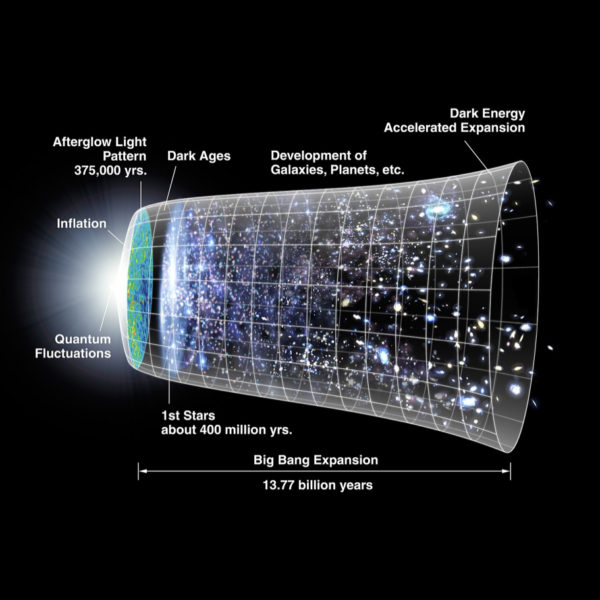Diagram of the evolution of the universe. Image credit: NASA/WMAP Science Team – Original version: NASA; modified by Cherkash, Public Domain, https://commons.wikimedia.org/w/index.php?curid=11885244
The universe is expanding. This we know from observing the relative motions of galaxies with respect to each other and to us. On average, galaxies are moving away from us, and from each other, with the velocity of the recession increasing proportionally with distance. However, different methodologies for measuring the proportionality between recession velocity and distance — known as the Hubble constant — have led to a disagreement between measurements of the flow in our near (and chronologically recent) cosmic vicinity compared to those further away in space (and further back in time). Understanding this possible digression from universality is fundamental to understanding our universe’s present, past, and future.
Gravitational waves offer a way to measure the Hubble constant independent of the two current methods. Several approaches have been proposed. Generally, they involve combining information from a gravitational-wave signal (to get the distance to the source) and electromagnetic observations of its host galaxy (to get the redshift of the source, from which we obtain its recessional velocity). GW170817 was the first of these “standard sirens”. Since an electromagnetic counterpart was observed with that signal, we were able to identify its host galaxy — NGC4993. Using the distance estimated from the gravitational wave signal and the known redshift of NGC4993, we were able to obtain an independent measurement of the Hubble constant. The value obtained, ~70km/s/Mpc, was consistent with both current measurements of the Hubble constant. Unfortunately, the measurement uncertainty of the GW170817’s distance was too large to distinguish between the two competing estimates that we have.
As gravitational-wave detectors improve and new ones come online, our ability to measure the Hubble constant with standard sirens will improve. I am particularly interested in what may be learned with the “3G” detectors Cosmic Explorer and Einstein Telescope. With their unprecedented reach, these detectors may have the ability to measure the Hubble constant out to large (z ~ 10) redshifts, perhaps without needing an electromagnetic counterpart. Such measurements would allow us to resolve the current discrepancy in the Hubble constant, and may even lead to a new cosmological paradigm.
